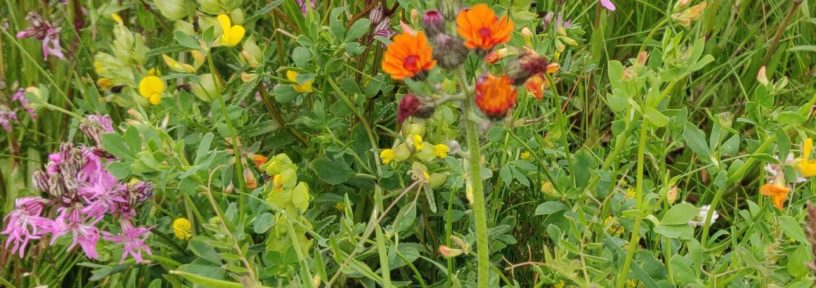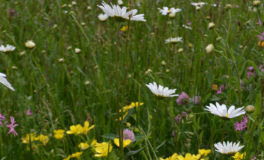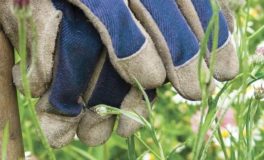Caring for your new Meadowmat Wildflower Turf
– If you’ve recently laid an area of Meadowmat Wildflower Turf – congratulations, you’ve made a great contribution to the wellbeing of wildlife in your area.All you need to do now is nurture those wild flowers to ensure you have a terrific floral display every year.
In this article, we will look at the basics in looking after your wildflower meadow. How to maximise the health of the plants in it, going week-by-week and looking at watering, weeding and mowing.
Here are the basics.
Watering your Meadowmat Wildflower Turf
Newly laid Meadowmat needs very little encouragement to root into your garden soil. The roots will be eager to stretch out and establish themselves in their new environment. But, in the first few weeks after installation, Meadowmat is vulnerable to drying out. So please take care to ensure that doesn’t happen.
Week 1: Water daily (maybe even twice a day)
Watering every day will help speed up the growth and rooting process naturally. If the weather is very hot and dry, you may need to water twice daily.If you possibly can, try to water in the evening, that way the water soaks into the soil and is less likely to evaporate in the heat of the day. Then, pull on a corner of your Meadowmat and check that the water has soaked through the root layer and into the soil beneath.
Use a watering can with a rose attachment or have a sprinkler on the end of a hosepipe. This is far gentler than pouring water on and is less likely to knock the plants over.
Week 2: Water every other day (unless the weather is very hot or very dry).
At week 2, there is less need to water every day. You can ease up on the watering. However, if it is a very hot or dry period, water every day to manage the high temperature and lack of rain.
You should soon start to see fresh white roots appearing on the underside of your Meadowmat. That means you’re doing a good job. No need to lift the Meadowmat to check from now on – you risk damaging the new roots if you do.
Week 3: Gradually start reducing the amount of water you use on your Meadowmat.
If you’ve been watering regularly, the soil beneath the matting should be reasonably moist by now and the roots will be getting stronger.
From week 3 onwards; (depending on the time of year), you’ll start to see changes in your Meadowmat. In spring or summer, you’ll notice that the leaves are growing rapidly and there may be a few flowers appearing – although this is unusual in very young Meadowmat.
Week 4: No more need to irrigate (except in the most extreme weather conditions)
Apart from the most extreme weather conditions, there should be no more need to water your Meadowmat. It should take care of itself if its laid on the ground but if your Meadowmat is on a green roof, please keep an eye on it, particularly if there is less than 150mm of substrate beneath it.
Weeding your Meadowmat wildflower turf
There should be very little need for weeding Meadowmat wild flower turf, especially in the first few months after installation. However, occasionally a rogue plant may rear its ugly head. Only if you’re confident that you know its a weed and you’re SURE it’s a weed, you can tweak it out either by hand or spot treat it with glyphosate.
Mowing your Meadowmat wildflower turf
In the first year, mowing times are largely dependent on when your Meadowmat was installed, what the weather has been like and what type of Meadowmat you have chosen.
You can of course mow paths through your Meadowmat so that you can walk among the flowers and get closer to the wildlife.
For the Traditional Meadowmat: Cottage Garden Meadowmat: Woodland Shade Meadowmat: Meadowmat Roof and Garden
| Month Installed | Care Regime (First 12 months) |
| March – June | If you laid your Meadowmat in the Spring, expect to make the first cut in late July or early August. If you experience storms and the vegetation gets knocked over – cut it back early rather than let it rot on the surface. Mow no shorter than 10cm (4 inches), preferably using a scythe. Leave the cuttings on top for a couple of days to dry out and drop their seeds, then remove every last one of them. In September/October time, check if the growth is lush, then run over it with a lawnmower on its highest setting. Keep the grass box on so that you can take the clippings away.
|
| July – August | Your turf may not need a big cut this year. Once roots are well established mow with a lawnmower and take away the clippings. This will help reduce soil fertility. DO NOT cut shorter than 10cm (4 inches)
|
| September – February | If the winter is mild and your Meadowmat has kept growing, a quick mow in early march will help reduce soil fertility and control grasses. Don’t cut it too short – 10cm is the bare minimum. Avoid cutting if frost is forecasted and always be sure to remove every last clipping. (the clippings make great compost)
|
For Meadowmat for Birds and Bees
| Month Installed | Care Regime (First 12 months) |
| March-June | Expect to make the first cut in late February or early March. If we experience storms and the vegetation gets knocked over – cut it back early rather than let it rot on the surface. Mow no shorter than 10cm (4 inches), preferably using a scythe. Leave the cuttings on top for a couple of days to dry out and drop their seeds, then remove every last one of them.
|
| July-August | Your wildflower turf shouldn’t need to be cut this year but you may not see flowers this summer so you have the ideal opportunity to manage soil fertility. Once roots are well established, and provided top growth is lush and healthy, mow with a lawnmower and take away the clippings. This will help reduce soil fertility. DO NOT cut shorter than 10cm (4 inches)
|
| September- February | The very best time of year to install Meadowmat! No need to cut Meadowmat for Birds and Bees until March. In March, if you want to, you can take the tips off the plants using a lawnmower on its highest setting. Remember not to cut it any less than 10cm tall.
|
Enjoying your new wildflower meadow
The most important thing to do with your new Meadowmat is enjoy it. Take photographs, watch small creatures scurrying about in the undergrowth – and then try to identify them or even capture the magic of the meadow with watercolour paints. The very best things I ever bought to go with my Meadow were:-
- A digital camera with a zoom lens (I love taking close-up shots)
- A wildflower identification book (lucky find on E-bay for £1.49)
- A beehive full of honey bees – but more on that another time

 Meadowmat Species
Meadowmat Species  How to lay Meadowmat wildflower turf
How to lay Meadowmat wildflower turf  When is the best time to lay Meadowmat?
When is the best time to lay Meadowmat? 

